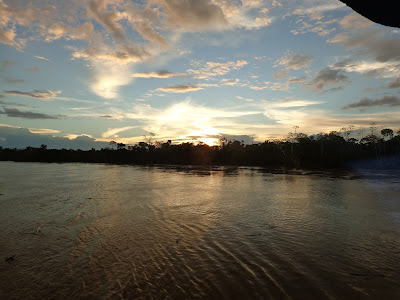As promised,
I will begin the second part of my Amazon jungle adventure with an introduction
to my new friends. The first smiling, friendly face I saw when I first walked
onto El Eduardo was a Chilean chap named Guillermo. It was he who helped me
gather information about when the boat would leave (mostly because he had no
idea himself). He introduced me to his girlfriend, Karolina, and we all went
out to grab some ice cream. We would soon bond more, for four days actually, as
we were the only foreigners on the boat amongst at least 250 Peruvians.
After four
days on the boat, we arrived to our destination: dusty, noisy, Iquitos. With
about 500,000 people, Iquitos is the biggest city in the world without road
connections. You can arrive by boat or by plane. Once you are there, you ride a
motorcycle. At any moment, it seems that all 500,000 people are buzzing around
on their motorcycles. With my visa running out, I had initial plans to head to
the Ecuadorian border straight away. Being on the river, three stories high,
seeing the jungle from above, gave us a feel for the jungle without truly
letting us in. It stoked a burning desire to get on the ground and go explore.
It was Guillermo and Karolina´s excitement for the jungle that really sold me
in joining them for three days on a ´jungle tour.´ It was us three, a German
gal, and our guide Larry who set out the net day on a boat taxi to a local´s
house which would be our ´base camp.´ The local, El Capitan, was our boat
driver an eagle eyes. He once spotted a pygmy monkey (a monkey the size of a
rat) in a 100 foot tree from 200 feet away – it was magic.
Boat is the
only form of transportation in the Amazon as almost all land is covered in
water for most of the year. We saw only a couple small patches in the three
days on our tour. The water mark from last year was still six feet above the
current water level. For anyone who can grasp the idea of six feet of water for
hundreds of square miles, that’s a lot of gallons.
Our tour
included various walks on the small patches of land, boat trips, and a night
sleeping in hammocks in a very remote spot. El Capitan drove, Larry would guide
with paddle and machete. We saw all types of strange animals. Pink fresh water
dolphins fed at the river mouths. El Capitan spotted young caimans while on a
night cruise, which he proceeded to catch with his bare hands. Larry spotted a
sloth in a tree, climbed the tree, and wrestled him down to eye level a foot
away. Peru has a massive diversity of birds and Larry an El Capitan could spot
them all.
The one
thing we saw most of was mosquitoes. They flocked in herds of the thousands. At
one point, after Karolina regrettably volunteered to cut the tomatoes for
dinner, there were four of us, El Capitan included, swatting the dark swarm of mozzies
away from her face. She was nearly in tears. On our camping trip, we had
mosquito nets over our hammocks. In the five seconds it took me to unzip the
net, hop in, and re-zip, at least 200 mozzies had made their way into my hammock
space. After I was in, a massacre even Hitler, Stalin, and Truman would have
been impressed. But, it’s odd how accustomed the natives are to mosquitoes.
They just swat unconsciously and often in mid conversation. Here come us city-folk
on red alert, search and destroy missions constantly; very akin to a puppy who
hears a fly buzzing around its head.
After my
three days in the jungle, El Eduardo couldn’t have been a more welcoming sight.
I had finally exited the heat and the constant barrage of mozzies. Two days of
full relaxation and hammock swinging were ahead of me. All I had to do was to enjoy
the scenery and eat rice, far away from the annoyances of the jungle.





